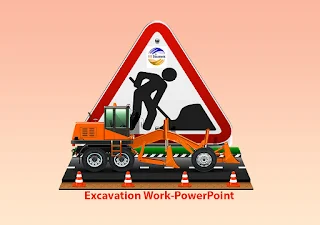Definition
Excavation work is the mechanism of moving earth, rock or other materials with heavy machinery e.g., tools, equipment or explosives. It also includes trenching, wall shafts, tunneling and underground. It is the preliminary activity of the construction project.
Excavation work is always the most hazardous operations and or work activity with heavy machinery on the worksite. A huge quantity of workforce gets serious injuries even limb damage or fatal death. Approximately up to 10- people die each year while carrying out their assignments working in and around excavations. One cubic meter of soil can weigh over one ton (the same as a new mini car)
To carry out daily work tasks, the procedure for excavation at a construction site includes:
- Understanding and acknowledgement of center line and for this, excavation drawings,
- Setting out of the plan on the ground,
- Excavation of soil and removal of excess soil.
- Quality checks such as recording ground level and marking of reference points should be done.
Drawings Requirement for Excavation
Center line or Grid line Drawing
Grid line drawings represent the grids marked in numbers and alphabets whose measurements are shown for site marking out the reference. These grid lines are so aligned that the line collapsed on the excavation and footing.
Excavation Drawing
The drawing of the excavation shows the length, width and depth of the excavation. The excavation line is distinct in the dotted line.
The Scope of the Work for Excavation
The major works were done before, while and after excavation are as follows:
- Commencement of corner benchmarks.
- Review and Survey for ground levels.
- Inspection and Survey for top levels
- approved depth of the Excavation.
- Dressing of loose and sloppy soil.
- Making up to cut off level
- Constructing de-watering wells and interconnecting trenches.
- Marking boundaries of the building.
- Constructing protection bunds and drains.
Working Method of Excavation
- The basic step includes in the excavation is to look for the intensity of soil and Clearing of the construction worksite is of bushes, weeds and plants etc.
- Setting out or ground tracing is the process of laying down the excavation lines and centre lines etc. on the ground before the excavation is started.
- Maximum of 4 and a minimum of 2 benchmarks are marked in the corner for the measurement of level. These benchmarks are highlighted on permanent structures like foundation, road or tree.
- The tracing or track is highlighted by lime powder.
- Regarding the drawing and benchmarks, the depth of the excavation is settled.
- Excavation is done by manual or mechanical means depending on the availability.
- The excavated soil is to either dispose of from the worksite or stocked around the excavation pit. Minimum of 1-metre distance must be kept between the stocking of excess soil and pit so that due to excessive rain or other forces (heavy machinery vibration movements) the soil should not sweep into the pits.
- Dressing of excavated pits is to be done as specified in the drawings.
- If the worksite is situated in loose soil area (sand), appropriate shoring must be done to hold and strengthen the loose soil.
- Construction of de-watering wells and interconnecting trenches are to provide if needed.
- All the sides of the building must be sealed and locked for safety reasons.
Removal of Excess Soil
Estimation of the excavated soil to be re-used in filling, gardening, preparing roads, etc. As far as possible try to carry excavation and filling together to negate double handling. Choose and stack the required appropriate material in such a place that it should not block other construction work. The excess or unwanted material should immediately be carried away and disposed of.
Quality Analyse for Excavation Work
- Recording basic ground level and analyze the size of the bottom of the excavation.
- Dispose of inappropriate material for filling.
- Stacking appropriate material for back filling to negate the double handling.
- Dressing bottom and sides of pits as per drawing concerning center line.
- Mandatory safety precautions observed.
- Quality Checks for Filling
- Recording initial ground level
- The sample is approved for back filling.
- Necessary marking/ reference points are established for the final level of back filling.
- Back filling is being carried out in layers (15 cm to 20 cm).
- Required watering, compaction is done.
- Required density is achieved.









No comments:
Post a Comment